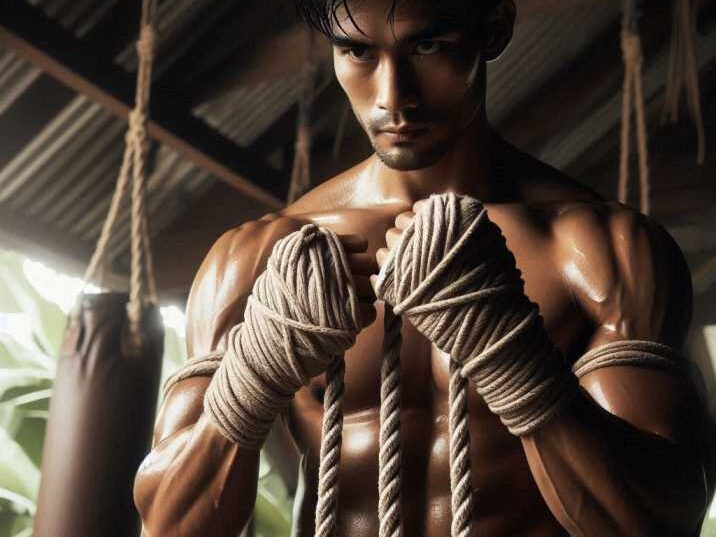Introduction
Table of Contents
Muay Thai, also known as the “Art of Eight Limbs,” is one of the most powerful and respected martial arts in the world. It originated in Thailand and has been practiced for centuries. One of the most interesting traditions in Muay Thai is the use of ropes, known as “Kaad Chuek.” These ropes were traditionally wrapped around a fighter’s hands before gloves became common. But why did Muay Thai fighters wear ropes? This article will explore the history, purpose, and benefits of wearing ropes in Muay Thai.

The History of Muay Thai Ropes (Kaad Chuek)
Origins of Kaad Chuek
Before modern boxing gloves were introduced, Muay Thai fighters used hemp ropes to wrap their hands and wrists. These wraps provided protection and also acted as a powerful striking tool. Kaad Chuek was common in early Muay Thai fights, where warriors competed in brutal battles without padded protection.
Rope-Wrapped Fighting in Ancient Thailand
In the past, Thai warriors used rope wraps in hand-to-hand combat to make their punches more effective. This technique was not only used in sports but also in real combat situations.
Transition to Modern Gloves
In the 20th century, Thailand introduced boxing gloves to make Muay Thai safer for competitors. However, Kaad Chuek is still used in some traditional fights, especially in Lethwei, a similar martial art from Myanmar.
Why Do Muay Thai Fighters Wear Ropes?
1. Hand and Wrist Protection
Muay Thai involves powerful punches, which can put immense stress on the hands and wrists. The ropes act as a protective barrier, reducing the risk of injuries like sprains or fractures. By securing the knuckles and wrists, they provide stability and support during impact. This was especially important in ancient times when gloves were not available.
2. Improved Striking Power
The tightly wrapped ropes add weight and density to a fighter’s fists, making each strike harder and more damaging. This increases the force of punches, making it more difficult for opponents to withstand blows. In historical battles, fighters relied on every advantage to defeat their rivals. The rough texture of the ropes could also cause cuts, adding an extra level of effectiveness.
3. Better Grip and Control
In Muay Thai, the clinch is a key technique used to control opponents in close-range combat. The friction from the rope wraps helps fighters maintain a stronger grip, preventing their hands from slipping. This advantage allows them to dominate in the clinch, land effective strikes, and control their opponent’s movement. A secure grip can mean the difference between winning and losing a fight.
4. Symbol of Tradition and Honor
Kaad Chuek is not just about fighting—it represents the deep-rooted history of Muay Thai. Wearing ropes is a way for fighters to pay tribute to the ancient warriors who practiced the art before them. It signifies respect for the traditions and discipline of the sport. Even in modern times, some fighters wear rope wraps in special events to honor this legacy.
5. Psychological Advantage
For many fighters, wearing ropes creates a strong mental connection to the past and gives them a sense of power. Feeling the rough texture of the ropes can remind them of their training, boosting confidence and focus. Some believe that this ancient practice instills a warrior’s mindset, making them feel tougher and more prepared for battle. The psychological boost can be just as important as physical preparation in a fight.
Table of Information
| Aspect | Details |
|---|---|
| Traditional Name | Kaad Chuek |
| Origin | Ancient Thailand |
| Purpose | Protection, Power, Tradition |
| Modern Replacement | Boxing gloves |
| Still Used In | Traditional Muay Thai, Lethwei |
| Benefits | Stronger strikes, better grip, cultural significance |
Conclusion
The tradition of wearing ropes in Muay Thai is deeply rooted in history and culture. While modern gloves have largely replaced them, Kaad Chuek remains a respected practice that showcases the power, skill, and spirit of Muay Thai. Whether for protection, enhanced striking, or tradition, rope wraps are an essential part of Muay Thai’s legacy. Fighters who wear them connect to the ancient roots of this martial art, keeping the spirit of Muay Thai alive for future generations.
FAQs
1. What is Kaad Chuek?
Kaad Chuek is the traditional Muay Thai practice of wrapping hands with ropes for protection and improved striking power.
2. Do modern Muay Thai fighters still wear ropes?
Most modern fighters use boxing gloves, but Kaad Chuek is still practiced in some traditional fights and events.
3. Are rope wraps better than gloves?
Rope wraps offer advantages like better grip and stronger strikes, but gloves provide more overall protection and are safer.
4. Where can I see traditional Muay Thai fights with rope wraps?
You can see traditional Kaad Chuek fights in Thailand, Myanmar, and special martial arts events.
5. How do you wrap your hands with ropes?
Ropes are wrapped tightly around the knuckles and wrists in layers to provide protection and strength.


